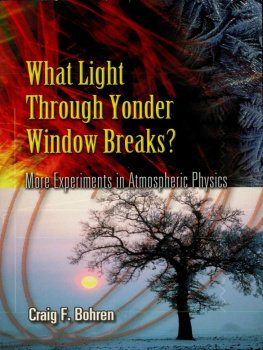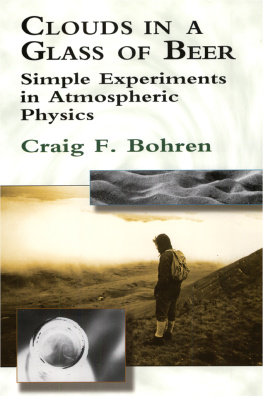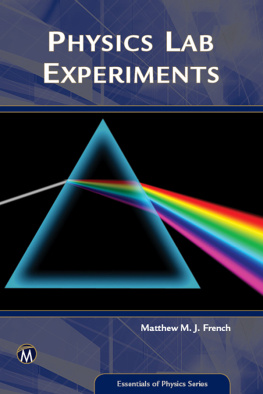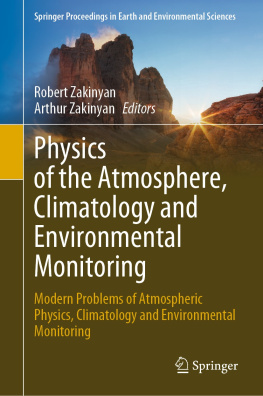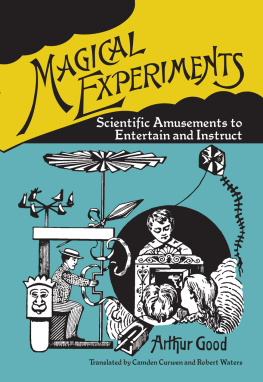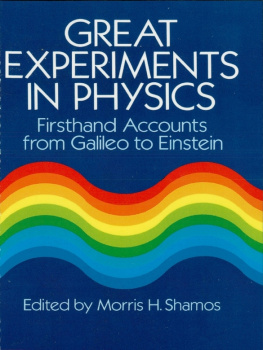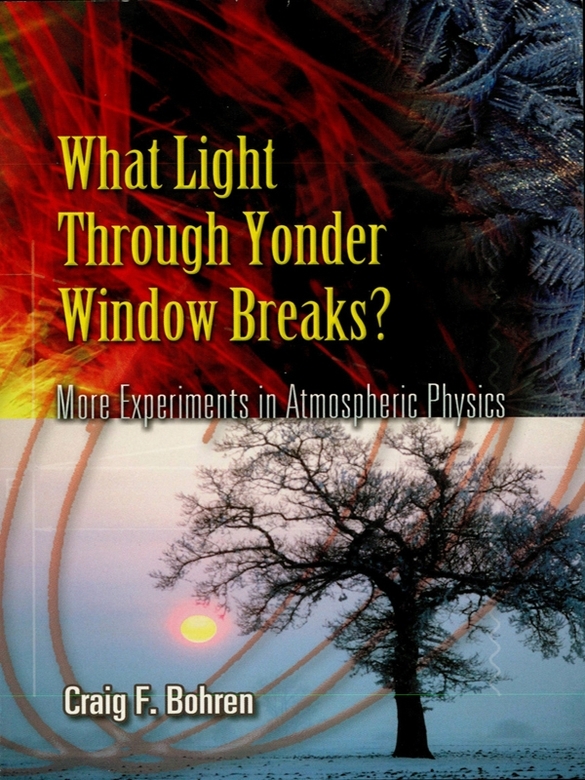Not surprisingly, the book that most closely resembles this one is my Clouds in a Glass of Beer (Wiley, 1987). My books are collections of essays in which I discuss in depth readily observable physical phenomena. Jearl Walkers unique Flying Circus of Physics (Wiley, 1977) is a collection of questions about many such phenomena, brief answers to them, and a long list of references to which readers are directed for more details. My books therefore complement his.
The only other popular science book I know about with windows as its theme is Elizabeth Woods superb Science from Your Airplane Window, which was reprinted by Dover in 1975 but is unavailable.
Chapter 1
In discussing dew points, one must keep in mind that the concept of a sharply defined temperature, at which condensation begins abruptly, represents only an approximation to the truth. This was pointed out by R. G. Wylie, D. K. Davies, and W. A. Caw in their paper The Basic Process of the Dew-Point Hygrometer in Humidity and Moisture, Vol. I, p. 125, Robert E. Ruskin, editor (Reinhold, 1965). These authors also note that in dew-point hygrometry, the usual simple concept of condensation is inadequate when the accuracy sought is higher than about 0.2 C.
The inspiring story of Wilson Bentley, a farmer with no more education than that obtainable in rural Vermont of a century ago who nevertheless made original contributions to atmospheric science, has been told admirably by Duncan Blanchard (Wilson Bentley: The Snowflake Man, Weatherwise, Vol. 23, 1970, p. 260; Bentley and Lenard: Pioneers in Cloud Physics, American Scientist, Vol. 60, 1972, p. 746).
The details of frost formation, like those of ice crystal formation in the atmosphere, depend on temperature and vapor density, as evidenced by the diagrams in U. Nakayas classic book Snow Crystals, Natural and Artificial (Harvard Univ. Press, 1954), in which he shows the different kinds of (artificial) ice crystalsdendrites, plates, needles, and so forthformed in different environments. Observations of natural ice crystals are consistent with what Nakaya observed in the laboratory.
Frost formation on glass (or any other surface) is essentially a two-dimensional process, whereas ice crystal formation in the atmosphere is three-dimensional. Nevertheless, there are similarities between the two processes. Dennis Lamb, our ice crystal expert at Penn State, tells me that when environmental conditions favor the formation of dendritic snow crystals, he finds dendritic frost patterns.
Chapter 2
Interference colors in soap bubbles are discussed in Soap Bubbles by C. V. Boys, one of the classics of popular science and still available as a Dover reprint. These colors are also treated in Soap Films (G. Bell, 1929) by A. S. C. Lawrence.
Diffusion rings are discussed in detail by A. J. de Witte (Interference in Scattered Light, American Journal of Physics, Vol. 35, 1967, p. 301).
Robert W. Wood discusses diffusion rings in his classic book Physical Optics (Macmillan, 1929)the second edition (pp. 242244), not the third, which was reprinted by Dover but again is out of print.
Chapter 3
Translations of the original paper setting down the Arago-Fresnel laws are found in W. F. Magies compilation A Source Book in Physics (McGraw-Hill, 1935) and in The Wave Theory of Light: Memoirs by Huygens, Young and Fresnel edited by Henry Crew (American Book Company, 1900). Magies book is the first place to look for hard-to-find scientific papers by our illustrious predecessors.
The advanced book from which I have learned the most about polarized light is William A. Shurcliffs Polarized Light (Harvard Univ. Press, 1962). At the popular level, I recommend Gunther P. Knnens Polarized Light in Nature (Cambridge Univ. Press, 1985), which has many color plates.
The history of the development of sheet polarizing filters has been told engagingly by Edwin Land in Some Aspects of the Development of Sheet Polarizers, Journal of the Optical Society of America, Vol. 41, 1951, p. 957.
Chapter 4
The ways in which the terms Brewster angle and polarizing angle have been used (and misused) are recounted by Akhlesh Lakhtakia in Would Brewster Recognize Todays Brewster Angle?, Optics News, Vol. 15, June 1989, p. 14.
Chapter 5
Albert Rosenfelds Introducing Dr. Irving Who ? ( Saturday Review, 4 March 1978, p. 46) is a short but good biographical sketch of Langmuir.
Harvey Leff, another connoisseur of light bulbs, has published an illuminating article in The Physics Teacher (Vol. 28, January 1990, p. 30): Illuminating Physics with Light Bulbs.
Chapter 6
One of the best and most well-known popular articles on mirages is Mirages by Alistair B. Fraser and William H. Mach ( Scientific American, January 1976, p. 102).
In a clever attempt to dispel the widespread misconception about the direct relation between refractive index and density, E. Scott Barr (Concerning Index of Refraction and Density, American Journal of Physics, Vol. 23, 1955, p. 623) plotted the one versus the other for several organic compounds. He connected these data points so that the resulting curve answered his question in the figure caption, Does index of refraction vary directly with density?: NO.
One chapter of Robert Greenlers superb book, Rainbows, Halos, and Glories (Cambridge Univ. Press, 1980), which is now available in paperback, is devoted to atmospheric refraction. Another good source on mirages (and much more besides) is M. Minnaerts The Nature of Light and Color in the Open Air (Dover, 1954).
For discussions of the moon illusion, see any good book on perception, such as Irving Rocks Perception (Freeman, 1984) or the book with the same title by Robert Sekuler and Randolph Blake (Knopf, 1985). An entire book devoted to this illusion, The Moon Illusion, edited by Maurice Hershenson, was published in 1989 by Lawrence Erlbaum Associates; the historical review by Cornelius Plug and Helen Ross and the annotated bibliography by Plug are by themselves worth the price of the book.
Everyone to whom I have shown David Joness The Inventions of Daedalus (Freeman, 1982) has been enchanted by it. Jones has the remarkable ability to spin scientific tales that straddle the border between the plausible and the implausible. One of Daedaluss plausible schemes is the optically flat earth, one with a radius such that rays of light would follow its curvature exactly, hence people would not have realized that the Earth was round until they discovered that, with a good telescope, you could see the back of your head. The refutation of the notion that rays of light could travel around the world was given by two spoilsports, Craig F. Bohren and Alistair B. Fraser (At What Altitude Does the Horizon Cease to be Visible?, American Journal of Physics, Vol. 54, 1986, p. 222).
Chapter 7
Despite the recent explosion of attention given to the greenhouse effect, its origins can be traced back almost two centuries. In Worlds in the Making (Harper, 1908), Svante Arrhenius asserts [t]hat the atmospheric envelopes limit the heat loss of the planets had been suggested about 1800 by the great French physicist Fourier.

